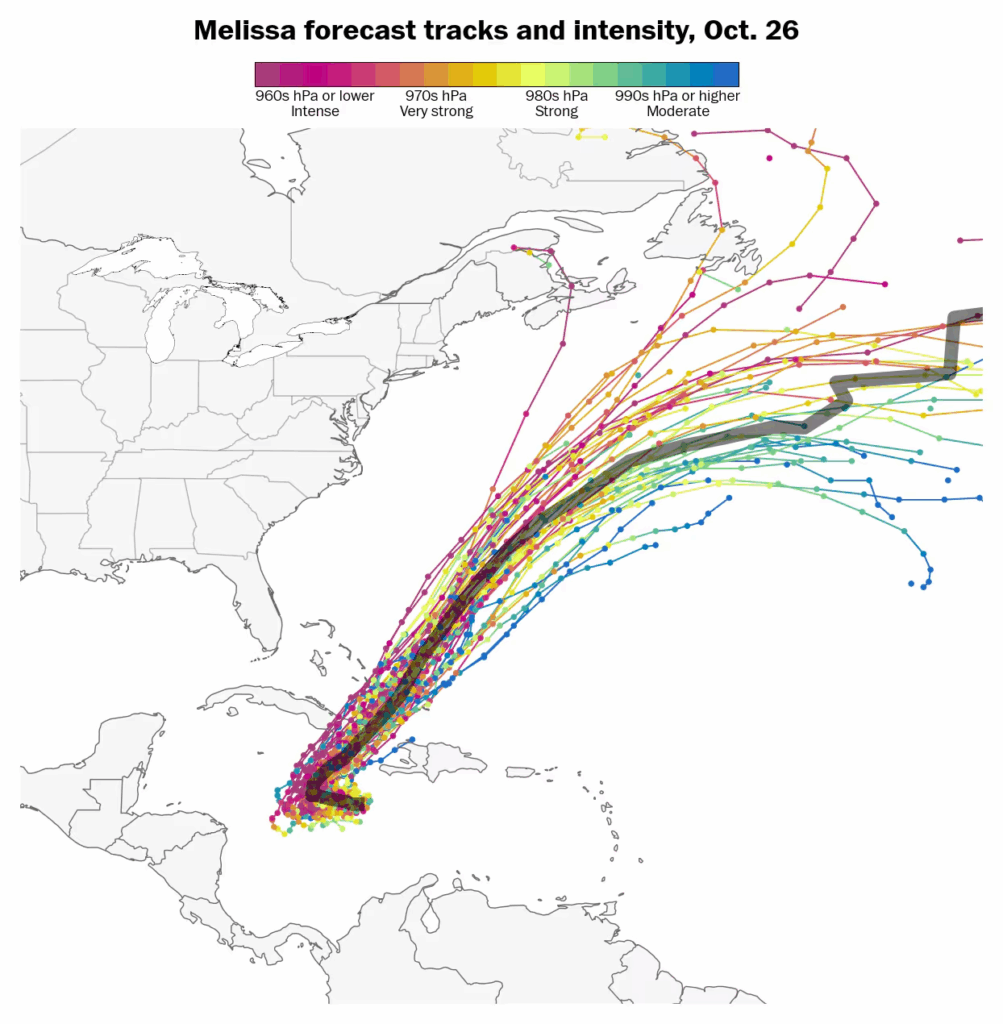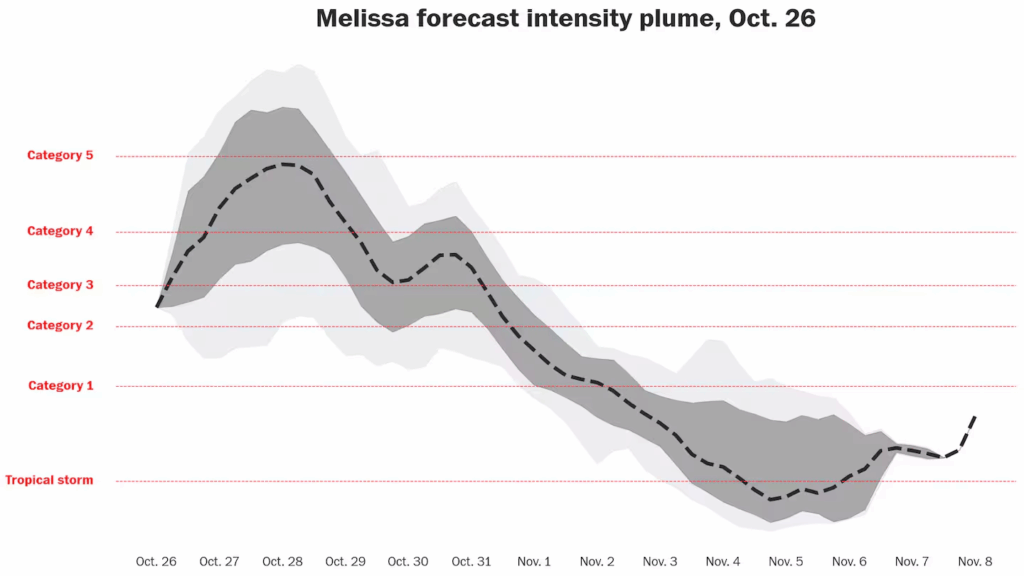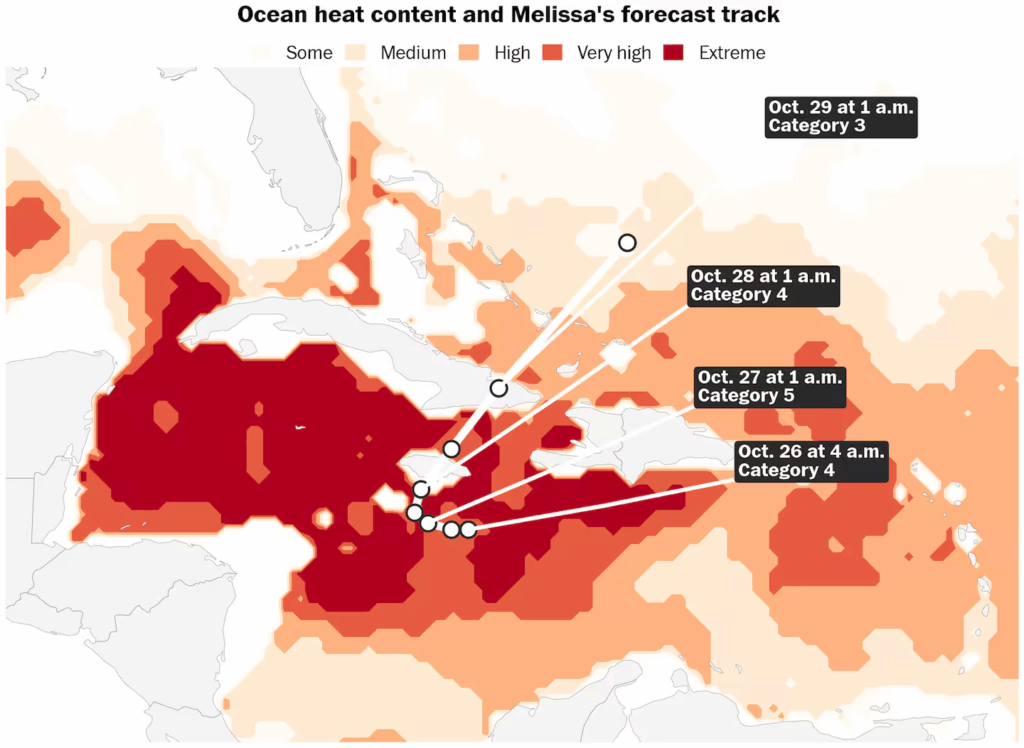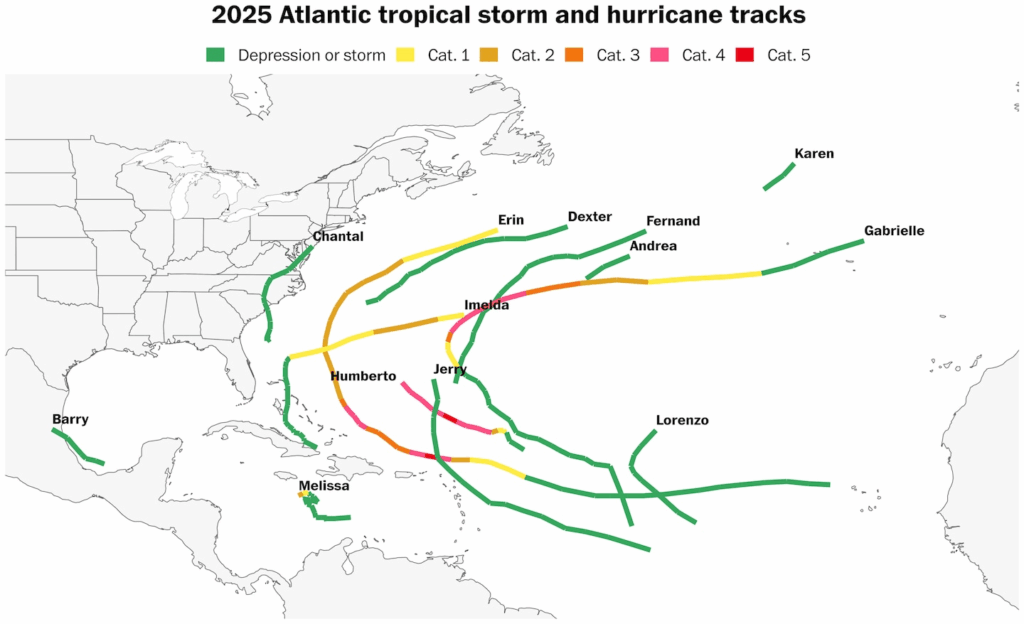Extreme Temperature Diary- Sunday October 26th, 2025/Main Topic: Hurricane Melissa- The Next Western Hemisphere Climate Crisis Tragedy After Palisades Fire for 2025 – Guy On Climate
Dear Diary. After the horrific January Southern California Palisades fire there hasn’t been a big climate change related incident the rest of this year across the Western Hemisphere. Yes, there have been historic heatwaves, but none causing thousands of deaths at any one time. That might unfortunately change because Hurricane Melissa is bearing down on Jamaica.
Melissa has all the hallmarks of a climate change influenced Hurricane. The Caribbean is at record warm levels, and the system has responded, undergoing rapid intensification since Saturday.
🔴⚠️🌀🇯🇲In less than 6 hours, #Melissa has intensified as #Hurricane of Cat.4 with winds at 225km/h, yet threatening Jamaica with heavy rains even before the full impact on Monday.⬇️Latest 12hrs via @zoom_earth with cat4 monster at sunrise in the Caribbean. #ClimateEmergency pic.x.com/IV02PhMAkk — Antonio Vecoli (@tonyveco on X) (@tonyveco.bsky.social) 2025-10-26T13:10:53.973Z
As of this Sunday it appears that Jamaica will get a direct strike from Melissa as a CAT4 or even a devastating CAT5 system. That would mean that Jamaica will experience the worst hurricane in its history. This situation reminds me of what happened to Puerto Rico in 2017 due to a CAT4 direct strike from Maria. That system killed more than 3,000 people. It took years for Puerto Rico to recover. I fear something similar will happen to Jamaica early this week unless Melissa can bypass the island nation by going much further west than forecast.
If current forecasts hold, Melissa will be the most powerful hurricane ever to strike Jamaica. Sustained winds at landfall may top 140 mph, along with localized rains of 40"+ and major storm surge. Here's my latest update with @drjeffmasters.bsky.social:
yaleclimateconnections.org/2025/10/meli... — Bob Henson (@bhensonweather.bsky.social) 2025-10-26T19:16:48.952Z
My Sunday update on explosive intensification of #HurricaneMelissa and why I fear a generational disaster is emerging
www.forbes.com/sites/marsha... — Marshall Shepherd (@drshepherd2013.bsky.social) 2025-10-26T12:04:54.902Z
Here are more details from the Washington Post:
Why Melissa’s intensification en route to Jamaica is so extraordinary – The Washington Post
Why Melissa’s intensification en route to Jamaica is so extraordinaryHurricane Melissa threatens to make a direct strike on Jamaica as the most powerful storm in its history. See how strong it will become and where it’s headed.October 26, 2025 at 6:56 a.m. EDT
 Satellite imagery shows Melissa rapidly intensifying from a tropical storm to a major hurricane between Saturday and Sunday. (Ben Noll/The Washington Post; data source: NOAA) Satellite imagery shows Melissa rapidly intensifying from a tropical storm to a major hurricane between Saturday and Sunday. (Ben Noll/The Washington Post; data source: NOAA)
By Ben Noll, Ruby Mellen, Brady Dennis and Matthew Cappucci
Jamaica is bracing for destruction as a rapidly intensifying Hurricane Melissa inches closer, threatening to make a direct strike as the most powerful storm to hit the nation in its history. The storm is expected to reach the main island as a Category 4 or 5 hurricane late Monday into early Tuesday.
Melissa, which was a tropical storm early Saturday, explosively strengthened into a Category 4 monster early Sunday — and it was still intensifying.
The storm will cause catastrophic flooding and landslides, exacerbated by its slow movement and Jamaica’s mountainous terrain. Up to 40 inches of rain as well as destructive winds and 9 to 13 feet of storm surge are expected leading up to and during landfall — probably including the area near the capital city of Kingston.
“Seek shelter now. Damaging winds and heavy rainfall today and on Monday will cause catastrophic and life-threatening flash flooding and numerous landslides before the strongest winds arrive Monday night and Tuesday morning,” the National Hurricane Center wrote in an update early Sunday.
The center said extensive infrastructural damage, long-duration power and communication outages and isolation of communities are expected.
And it’s possible Melissa could make three landfalls in fewer than three days.
In addition to Jamaica, home to about 2.8 million people, dangerous rain-related impacts from Melissa will also continue to be felt in Haiti, where at least three people have died according to local reports, as well as the Dominican Republic. Then the strong storm will strike eastern Cuba late Tuesday into Wednesday as a major hurricane, followed by the southern Bahamas and Turks and Caicos Islands from Wednesday into Thursday.
Hurricane Melissa hazardous wind forecast Sustained winds are at least 74 mph for hurricanes and 39 mph for tropical storms. All times Eastern. Source: National Weather Service (DYLAN MORIARTY, ADITYA JAIN, AND SZU YU CHEN/THE WASHINGTON POST) Sustained winds are at least 74 mph for hurricanes and 39 mph for tropical storms. All times Eastern. Source: National Weather Service (DYLAN MORIARTY, ADITYA JAIN, AND SZU YU CHEN/THE WASHINGTON POST)
Melissa’s power is particularly notable. If the storm reaches Category 5 strength as predicted, it will become the third such storm to do so this Atlantic season — the second-highest total for any season on record and part of a trend toward more intense storms.
Melissa is churning across some of the warmest ocean waters in the world, which are also warmer than average, fueling violent thunderstorms that are efficiently converting oceanic heat and moisture into powerful updrafts — a process that accelerated Melissa’s strengthening and led to the formation of a clear, symmetric eye.
The system is unlikely to directly affect the United States, guided out to sea by another storm near the East Coast next week, but some of its moisture could surge into New England and Atlantic Canada, contributing to late-week downpours.
 Hurricane Melissa is forecast to make landfall in several places as it travels north over the next week, including Jamaica and eastern Cuba, probably followed by the Bahamas. It will most likely miss North America. Each line indicates a possible forecast track, color-coded by strength. The black line represents the middle outcome of all of the colored lines. (Ben Noll/The Washington Post; data source: ECMWF) Hurricane Melissa is forecast to make landfall in several places as it travels north over the next week, including Jamaica and eastern Cuba, probably followed by the Bahamas. It will most likely miss North America. Each line indicates a possible forecast track, color-coded by strength. The black line represents the middle outcome of all of the colored lines. (Ben Noll/The Washington Post; data source: ECMWF)
Melissa now a major hurricaneMelissa was a Category 4 hurricane early Sunday, with sustained winds of 140 mph and higher gusts.
A day ago, Melissa had winds of 70 mph — which means it easily surpassed the threshold of 35 mph over 24 hours for a rapidly intensifying system.
In fact, Melissa’s pace of strengthening was twice the rate needed to qualify as rapid, making the storm extraordinary.
Thunderstorms blossoming near the core of Melissa released heat energy to the surrounding environment, warming the surrounding air and helping it to rise. That lifts air away from the surface, meaning there’s simply less air present in the middle of the storm. Less air means less air pressure. That missing air creates a void of sorts; air rushes in from outside the storm to fill that void. That’s where wind comes from — the more dramatic the deficit of air, the stronger the winds.
In Melissa’s case, about 6 to 7 percent of the atmosphere’s ambient mass is missing from the storm’s center. As that deficit grows, winds will further strengthen.
Early Sunday, Melissa was about 120 miles southeast of Kingston and 280 miles southwest of Port-au-Prince, Haiti, lumbering along to the west at 5 mph. Its strengthening had slowed, or even plateaued. That’s to be expected as hurricanes don’t intensify linearly, but rather in fits and bursts. It will probably begin to intensify abruptly on Sunday evening.
Melissa spent part of Saturday drifting slightly south of due west. (Some meteorologists refer to southward-drifting storms as “gold-diggers,” since their digging, or southward, motion can bring them closer to extremely warm waters.) Indeed, Melissa now has slightly longer to spend over the warmest waters of the Atlantic and intensify further.
Hurricane warnings covered all of Jamaica, while watches were in effect for southern Haiti and the four easternmost provinces of Cuba. Tropical storm warnings also covered southern Haiti.
On Sunday morning, the Hurricane Hunters found Melissa’s eye to be 16 degrees warmer than the surrounding air outside the eye. Hurricanes are warm-core systems reminiscent of chimneys. The column of exceptional warmth at the center is a sign of an intense storm.
According to a weather model from Google, the storm has more than an 80 percent chance of intensifying into a Category 5 hurricane. The storm may fluctuate in intensity late Monday into Tuesday, so it’s unclear if it will be a Category 4 or 5 at landfall. Regardless, severe impacts are inevitable.
 Hurricane Melissa will probably peak at Category 5 intensity before making landfall in Jamaica on Monday. Category 5 hurricanes feature maximum sustained winds of at least 157 mph near their center. (Ben Noll/The Washington Post; data source: Google/DeepMind) Hurricane Melissa will probably peak at Category 5 intensity before making landfall in Jamaica on Monday. Category 5 hurricanes feature maximum sustained winds of at least 157 mph near their center. (Ben Noll/The Washington Post; data source: Google/DeepMind)
Life-threatening flash flooding, landslides and storm surge will probably hit southeastern Cuba on Tuesday, before the southern Bahamas and Turks and Caicos are lashed on Wednesday.
Why Melissa is so concerningA slow, lumbering storm like Melissa is cause for great concern.
“In many cases, it’s a worst-case kind of scenario,” said Jeff Masters, a meteorologist who writes on climate change and weather for Yale Climate Connections and for years served with NOAA’s Hurricane Hunters.
A storm that inches along can subject places in its path to longer stretches of torrential rainfall, sustained winds and heightened storm surge. With Melissa, Masters said, he worries about the potential rainfall most of all.
Jamaica, for instance, is not especially susceptible to storm surge, though the airport in Kingston is low-lying and at risk of flooding, Masters said. In addition, he said, many structures on the island were rebuilt to withstand stronger wind speeds after the devastation of Hurricane Gilbert in 1988.
But, Masters said, the island is home to steep terrain that can be conducive to flash floods and mudslides.
Because tropical cyclones thrive on warm water, a storm that lingers in one spot can sometimes stir up cooler, deeper water and eventually weaken itself. But Masters pointed out that in parts of the region where Melissa is set to crawl along, the waters are 86 degrees as far as 200 feet below the surface.
“Unfortunately,” he said, “it’s over a part of the Caribbean that has deep, warm water.”
 Melissa’s journey over extremely high ocean heat are powering it toward Category 5 strength. (Ben Noll/The Washington Post; data source: NOAA/CoastWatch) Melissa’s journey over extremely high ocean heat are powering it toward Category 5 strength. (Ben Noll/The Washington Post; data source: NOAA/CoastWatch)
Jim Kossin, a retired NOAA climate scientist and hurricane expert, said that while it is clear climate change is making the strongest storms even stronger, researchers are continuing to investigate whether the planetary changes are also leading to more slow-moving storms that dump huge amounts of rain.
“There is a lot of observational evidence that this is happening more often now,” Kossin said.
He noted that Hurricane Harvey, which dumped as much as 5 feet of rain in parts of the Houston region in 2017, is “the poster child” of what is possible when a large storm stalls. “The whole area was just absolutely inundated with rainfall. The rain just kept falling in the same place.”
He, too, expressed worry about the multiple feet of rain that could fall on Jamaica, saying the mountains can make for “compounding events” such as flash flooding and mudslides that are as unpredictable as they are destructive and deadly.
“That’s the really scary part of these things,” Kossin said.
A benign season no moreUntil Melissa, this year saw “one of the most benign hurricane seasons in a long time,” said Phil Klotzbach, a senior research scientist for the Department of Atmospheric Science in the Walter Scott Jr. College of Engineering at Colorado State University.
Over the summer, several monster storms have formed in the ocean and slowly crept toward land before hooking and swiveling back out to sea.
 Melissa is the 13th named storm of the Atlantic season and the fourth major hurricane. (Ben Noll/The Washington Post; data source: NOAA) Melissa is the 13th named storm of the Atlantic season and the fourth major hurricane. (Ben Noll/The Washington Post; data source: NOAA)
It’s been a lucky stretch as hurricanes trend toward becoming more powerful and destructive.
Melissa is set to break that quiet streak amid prime conditions for a formidable storm.
“I think our luck is going to run out,” Klotzbach said.
Here are more “ETs” recorded from around the planet the last couple of days, their consequences, and some extreme temperature outlooks, as well as any extreme precipitation reports:
NORTH AFRICA HISTORIC HEAT 43c
Unprecedented heat with hundreds of stations up to 6C above records for this time of the year
43C Mauritania,42 Senegal and Mali (mins >28),41 Chad and Niger,40 Algeria and Tunisia
Absolutely crazy 39C Enfidhia on the coast
October record smashed — Extreme Temperatures Around the World (@extremetemps.bsky.social) 2025-10-26T16:11:01.164Z
Impressive contrasts also in SOUTHERN AFRICA
Brutal heat moved to Mozambique with up to 43C and Madagascar (almost 39C on the coast)
while a sudden polar front arrived in SW Africa with a temperature drop of 15C+.
Tomorrow Mozambique might break records with 30C nights — Extreme Temperatures Around the World (@extremetemps.bsky.social) 2025-10-26T15:12:46.500Z
EXTRAORDINARY HEAT IN AUSTRALIA
Deadly heat continues in this monthly long record heat wave with hundreds of records pulverized:
Today records
44.1 Julia Creek
44 Longreach
HIGH MINIMUMS
27.9 Hughenden
25 Mackay
24.2 Rosslyn Bay
23.9 Gladstone 24.8 AP
24.5 17 70
24.8 Rundle Is — Extreme Temperatures Around the World (@extremetemps.bsky.social) 2025-10-26T05:39:24.243Z
SOUTH AMERICA: Extremely dynamic spring
From exceptional heat >42C
(tonight MINIMUM 29.7 Cuiaba,Brazil)
to a temperature crash of 10C+.
For the next 5 days the frying pan El Chaco will barely touch 30C,some days not even 25C. — Extreme Temperatures Around the World (@extremetemps.bsky.social) 2025-10-26T14:55:27.565Z
Indonesia record heat is unstoppable:
Today 26 October it was the hottest night in history for any month at Tanjung Karang (Sumatra) with a minimum temperature of 26.0C — Extreme Temperatures Around the World (@extremetemps.bsky.social) 2025-10-26T01:17:55.971Z
RECORD HEAT IN NEW CALEDONIA
Hot air reached the already record warm New Caledonia.
Records smashed allover:
Ile Surprise min 25.7 Max. 35.8
HOTTEST DAY AND NIGHT IN NEW CALEDONIA HISTORY
More monthly records:
32.5 Ile Mare
30.5 Ile Chesterfield — Extreme Temperatures Around the World (@extremetemps.bsky.social) 2025-10-26T10:08:08.530Z
November 1st in EUROPE
will start with exceptional mildness with warm air from NW Africa moving North and than Eastward.
Expect exceptional mild conditions with dozens of records from South to North, from West to East.
Only Italy and NE Europe will be untouched. — Extreme Temperatures Around the World (@extremetemps.bsky.social) 2025-10-26T12:48:36.042Z
Please read “Saving Us: A Climate Scientist’s Case for Hope and Healing in a Divided World” by @katharinehayhoe.com
Thinking of everyone in Jamaica and Haiti and hoping for their safety 🙏 — (@jenvogt.bsky.social) 2025-10-26T16:58:23.313Z
Two new artificial intelligence #AI data centres proposed for Edinburgh would demand the equivalent amount of energy as building five cities.
www.thenational.scot/news/2557065... — Dr Paul Dorfman (@drpauldorfman.bsky.social) 2025-10-26T08:20:09.444Z
Have you noticed plane turbulence is getting worse?
It’s not your imagination. It’s climate change. — Katharine Hayhoe (@katharinehayhoe.com) 2025-10-26T17:11:03.344Z
Also, while we are on the topic of aviation did you know that half of all climate forcing from aviation could be eliminated by avoiding formation of persistent contrails?!
By @kencaldeira.com and colleagues: — Katharine Hayhoe (@katharinehayhoe.com) 2025-10-26T17:14:19.065Z
I was recently invited to present my thoughts on the role of universities in the #climate crisis
Several audience members asked that I share my slides, so I've decided to post them here too as an open resource
I'd love any feedback, & for you to share examples of projects & best practice.
Long 🧵😊 — Dr. Aaron Thierry (@thierryaaron.bsky.social) 2025-10-26T04:56:52.576Z
2/ Higher education institutions have a key role to play in responding to the #climate crisis.
However, there is a growing action gap.
The purpose of this talk is to critically examine current responses & offer suggestions.
Its urgent that universities fully support transformative climate action! — Dr. Aaron Thierry (@thierryaaron.bsky.social) 2025-10-26T04:56:52.577Z
]
]#Wx: “La Niña often, but not always, leads to higher odds of drier conditions in the southern part of the state” The North is a Coin Toss.
www.mercurynews.com/2025/10/09/l... — Silicon Valley North - Citizens Climate Lobby (@cclsvn.bsky.social) 2025-10-26T17:50:47.020Z
#Evs + #Economy: "S&P Global Mobility predicts only around 3 million EVs will be produced that year, and some would likely use batteries imported from other countries." The Battery Belt Gets Quieter.
www.inquirer.com/business/ev-... — Silicon Valley North - Citizens Climate Lobby (@cclsvn.bsky.social) 2025-10-26T17:48:21.930Z
If we switched to #renewableenergy, the number of ships crossing the ocean would fall by 40% because they're just carrying coal & oil & gas!! buff.ly/dpTrSpO
We have the solutions. Implement them. #ActOnClimate
#ClimateAction #climate #energy #GreenNewDeal — Mike Hudema (@mikehudema.bsky.social) 2025-10-26T18:07:05.112Z
UK #solar power rose by a third in the first six months of this year.
August this year, China exported 46 gigawatts of panels in a single month—that’s roughly equivalent to 46 large coal or #nuclear power plants.
www.prospectmagazine.co.uk/ideas/techno... — Dr Paul Dorfman (@drpauldorfman.bsky.social) 2025-10-26T08:18:45.544Z
— Dr Paul Dorfman (@drpauldorfman.bsky.social) 2025-10-26T18:28:00.747Z
America’s biggest offshore wind farm will be online in 6 months.
Dominion Energy’s 2.6 GW project off Virginia’s coast is progressing fast. The utility has a new, more definitive target to plug into the grid: March 2026.
grist.org/energy/ameri...
#Wind #Ocean #Virginia #Climate #Energy — Grist (@grist.org) 2025-10-24T22:37:06.654Z
1% of world’s coastal waters could, in theory, generate enough offshore #wind and #solar power to provide a third of the world’s electricity by 2050. But turning that potential into reality is another story.
#RenewableEnergy #climate
theconversation.com/just-1-of-co... — Dr Paul Dorfman (@drpauldorfman.bsky.social) 2025-10-26T08:17:03.378Z
— Dr Paul Dorfman (@drpauldorfman.bsky.social) 2025-10-26T08:41:08.631Z
www.newcivilengineer.com/opinion/a-go... — Dr Paul Dorfman (@drpauldorfman.bsky.social) 2025-10-26T08:41:40.285Z
Trump targets federal employees working on conservation and environmental protection.
grist.org/labor/trump-...
#Nature #Environment #Conservation #Climate — Grist (@grist.org) 2025-10-26T15:10:09.277Z
For further discussion, see: — Katharine Hayhoe (@katharinehayhoe.com) 2025-10-26T13:26:11.042Z
Yes, solutions for nature are also solutions for health!
This new analysis finds urban greening is "associated with a wide range of positive health outcomes including improved physical and mental health, increased physical activity, improved childhood development, and reduced exposure to harms." — Katharine Hayhoe (@katharinehayhoe.com) 2025-10-26T13:24:22.260Z
|





 Satellite imagery shows Melissa rapidly intensifying from a tropical storm to a major hurricane between Saturday and Sunday. (Ben Noll/The Washington Post; data source: NOAA)
Satellite imagery shows Melissa rapidly intensifying from a tropical storm to a major hurricane between Saturday and Sunday. (Ben Noll/The Washington Post; data source: NOAA) Sustained winds are at least 74 mph for hurricanes and 39 mph for tropical storms. All times Eastern. Source: National Weather Service (DYLAN MORIARTY, ADITYA JAIN, AND SZU YU CHEN/THE WASHINGTON POST)
Sustained winds are at least 74 mph for hurricanes and 39 mph for tropical storms. All times Eastern. Source: National Weather Service (DYLAN MORIARTY, ADITYA JAIN, AND SZU YU CHEN/THE WASHINGTON POST) Hurricane Melissa is forecast to make landfall in several places as it travels north over the next week, including Jamaica and eastern Cuba, probably followed by the Bahamas. It will most likely miss North America. Each line indicates a possible forecast track, color-coded by strength. The black line represents the middle outcome of all of the colored lines. (Ben Noll/The Washington Post; data source: ECMWF)
Hurricane Melissa is forecast to make landfall in several places as it travels north over the next week, including Jamaica and eastern Cuba, probably followed by the Bahamas. It will most likely miss North America. Each line indicates a possible forecast track, color-coded by strength. The black line represents the middle outcome of all of the colored lines. (Ben Noll/The Washington Post; data source: ECMWF) Hurricane Melissa will probably peak at Category 5 intensity before making landfall in Jamaica on Monday. Category 5 hurricanes feature maximum sustained winds of at least 157 mph near their center. (Ben Noll/The Washington Post; data source: Google/DeepMind)
Hurricane Melissa will probably peak at Category 5 intensity before making landfall in Jamaica on Monday. Category 5 hurricanes feature maximum sustained winds of at least 157 mph near their center. (Ben Noll/The Washington Post; data source: Google/DeepMind) Melissa’s journey over extremely high ocean heat are powering it toward Category 5 strength. (Ben Noll/The Washington Post; data source: NOAA/CoastWatch)
Melissa’s journey over extremely high ocean heat are powering it toward Category 5 strength. (Ben Noll/The Washington Post; data source: NOAA/CoastWatch) Melissa is the 13th named storm of the Atlantic season and the fourth major hurricane. (Ben Noll/The Washington Post; data source: NOAA)
Melissa is the 13th named storm of the Atlantic season and the fourth major hurricane. (Ben Noll/The Washington Post; data source: NOAA)